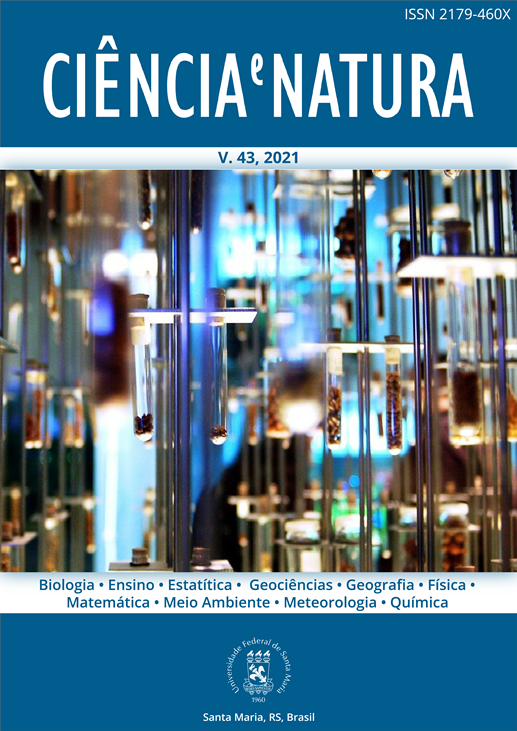Soma iterada de algarismos de um número racional
DOI:
https://doi.org/10.5902/2179460X41972Palavras-chave:
Aplicação soma de algarismos, Congruência, Divisibilidade, Órbita e Soma iterada de algarismosResumo
A soma iterada de algarismos, S* (n), sendo n um número inteiro positivo, é o algarismos 0 ≤ b ≤ 9 obtido por meio de um processo iterativo da aplicação S(n), a soma de algarismos (dígitos) do número n, em que cada iteração é obtida a partir do resultado anterior de modo a restar apenas o algarismo b. Por exemplo, a soma iterada de 999999 é igual a 9, pois 9+9+9+9+9+9=54 e 5+4=9, ou seja S(999999) = 54 e S(54) = 9, assim S* (999999) = 9. A soma dos algarismos de um número inteiro positivo, e até a soma iterada de algarismos, é assunto recorrente em olímpiadas de matemática e foi abordado em diversos trabalhos, por exemplo em Ghannam(2012), Ismirli(2014) ou Lin(2016). Neste estendemos a aplicação S* a um número racional positivo x com representação decimal finita. Destacamos o seguinte resultado: dado um número racional positivo x, com representação decimal finita, e soma dos seus algarismos 9, então quando x é dividido por potências de 2, o número resultante também tem a soma dos seus algarismos igual a 9. Tal fato também ocorre quando o número x é dividido por potências de 5. Resultados similares foram encontrados quando a soma dos algarismos de x for 3 ou 6.
Downloads
Referências
Cooper, C. N.; Kennedy, Robert E. On consecutive Niven numbers. Fibonacci Quart, volume 21, 1993 (146–151).
Costa, Eudes A.; Mesquita, Élis Gardel da C. O Número Mágico M. Revista da Olimpíada, volume 9, 2014 (33–43).
Domingues, Hygino Hugueros. Fundamentos de aritmética. Editora da UFSC, 2009.
Ghannam, Talal. The Mystery of Numbers: Revealed Through their Digital Root . Talal Ghannam publisher. 2012.
Guy, Richard. Unsolved problems in number theory. Springer Science & Business Media. 2013
Izmirli, Ilhan M. On Some Properties of Digital Roots. Advances in Pure Mathematics, volume 4, 06, 2014 (295).
Koninck, Jean-Marie; Doyon, Nicolas; Kátai, Imre. On the counting function for the Niven numbers. Acta Arithmetica, volume 106, 03, 2003 (265–275) .
Lakatos, E. M.; Marconi, M. A. Fundamentos de Metodologia Científica. São Paulo: Atlas Editora, 2017.
Lin, Chia-Yu. Digital root patterns of three-dimensional space Recreational Mathematics Magazine, volume 3, 05, 2016 (9–31).
Meyer, Maximiliano. Nikola Tesla, o gênio mais injustiçado da história. Oficina da Net. https://www.oficinadanet.com.br/post/14537-nikola-tesla-o-genio-mais-injusticadoda- história acesso em: 07 nov. 2018.
McDaniel, Wayne L. The existence of infinitely many k-Smith numbers. Fibonacci Quart, volume 25 , 1987 (76–80).
Oltikar, Sham; Wayland, Keith. Construction of Smith numbers . Mathematics Magazine, volume 56, 1, 1983 (36–37).
Pereira, Valberto R. F.. Domingo regado a Repunits. Eureka (SBM-OBM), volume 29, 2009. www.obm.org.br
Pickover, C. A. A Brief History of Smith Numbers. Wonders of Numbers: Adventures in Mathematics, Mind, and Meaning, volume56, 104, 1983 (247–248).
Rodrigues, Flávio Wagner. A prova dos nove. Revista do Professor de Matetática, 14, 2004 (1–3).
Voight, John. Perfect numbers: an elementary introduction. University of California journal Berkley, 1998.
Yates, Samuel. Special sets of Smith numbers. Mathematics Magazine, volume 59, 05, 1986 (293–296).
Zeitz, Paul. The art and craft of problem solving. John Wiley New York publisher. 1999.
Publicado
Como Citar
Edição
Seção
Licença
Para acessar a DECLARAÇÃO DE ORIGINALIDADE E EXCLUSIVIDADE E CESSÃO DE DIREITOS AUTORAIS clique aqui.
Diretrizes Éticas para Publicação de Revistas
A revista Ciência e Natura está empenhada em garantir a ética na publicação e na qualidade dos artigos.
A conformidade com padrões de comportamento ético é, portanto, esperada de todas as partes envolvidas: Autores, Editores e Revisores.
Em particular,
Autores: Os Autores devem apresentar uma discussão objetiva sobre a importância do trabalho de pesquisa, bem como detalhes e referências suficientes para permitir que outros reproduzam as experiências. Declarações fraudulentas ou intencionalmente incorretas constituem comportamento antiético e são inaceitáveis. Artigos de Revisão também devem ser objetivos, abrangentes e relatos precisos do estado da arte. Os Autores devem assegurar que seu trabalho é uma obra totalmente original, e se o trabalho e / ou palavras de outros têm sido utilizadas, isso tem sido devidamente reconhecido. O plágio em todas as suas formas constitui um comportamento publicitário não ético e é inaceitável. Submeter o mesmo manuscrito a mais de um jornal simultaneamente constitui um comportamento publicitário não ético e é inaceitável. Os Autores não devem submeter artigos que descrevam essencialmente a mesma pesquisa a mais de uma revista. O Autor correspondente deve garantir que haja um consenso total de todos os Co-autores na aprovação da versão final do artigo e sua submissão para publicação.
Editores: Os Editores devem avaliar manuscritos exclusivamente com base no seu mérito acadêmico. Um Editor não deve usar informações não publicadas na própria pesquisa do Editor sem o consentimento expresso por escrito do Autor. Os Editores devem tomar medidas de resposta razoável quando tiverem sido apresentadas queixas éticas relativas a um manuscrito submetido ou publicado.
Revisores: Todos os manuscritos recebidos para revisão devem ser tratados como documentos confidenciais. As informações ou ideias privilegiadas obtidas através da análise por pares devem ser mantidas confidenciais e não utilizadas para vantagens pessoais. As revisões devem ser conduzidas objetivamente e as observações devem ser formuladas claramente com argumentos de apoio, de modo que os Autores possam usá-los para melhorar o artigo. Qualquer Revisor selecionado que se sinta desqualificado para rever a pesquisa relatada em um manuscrito ou sabe que sua rápida revisão será impossível deve notificar o Editor e desculpar-se do processo de revisão. Os Revisores não devem considerar manuscritos nos quais tenham conflitos de interesse resultantes de relacionamentos ou conexões competitivas, colaborativas ou outras conexões com qualquer dos autores, empresas ou instituições conectadas aos documentos.






